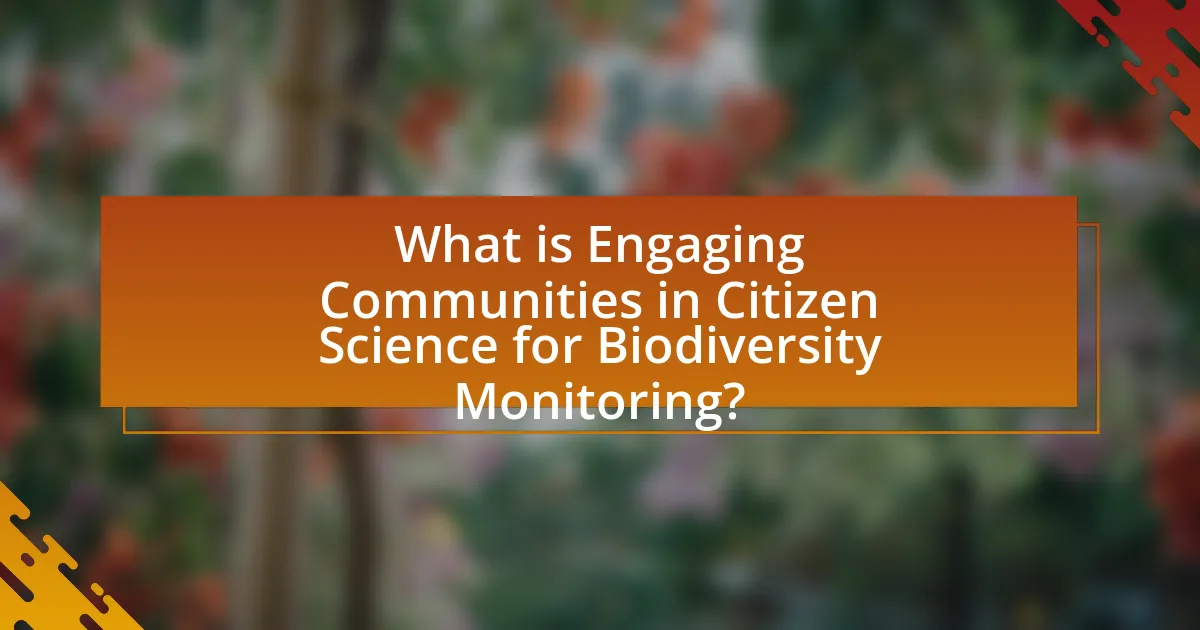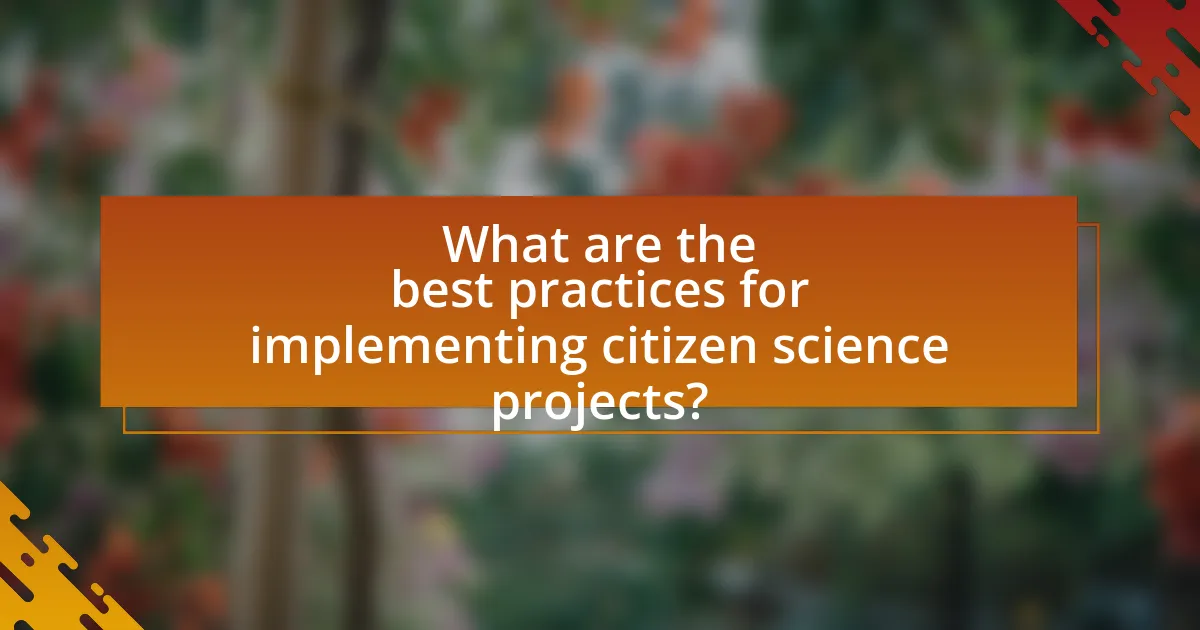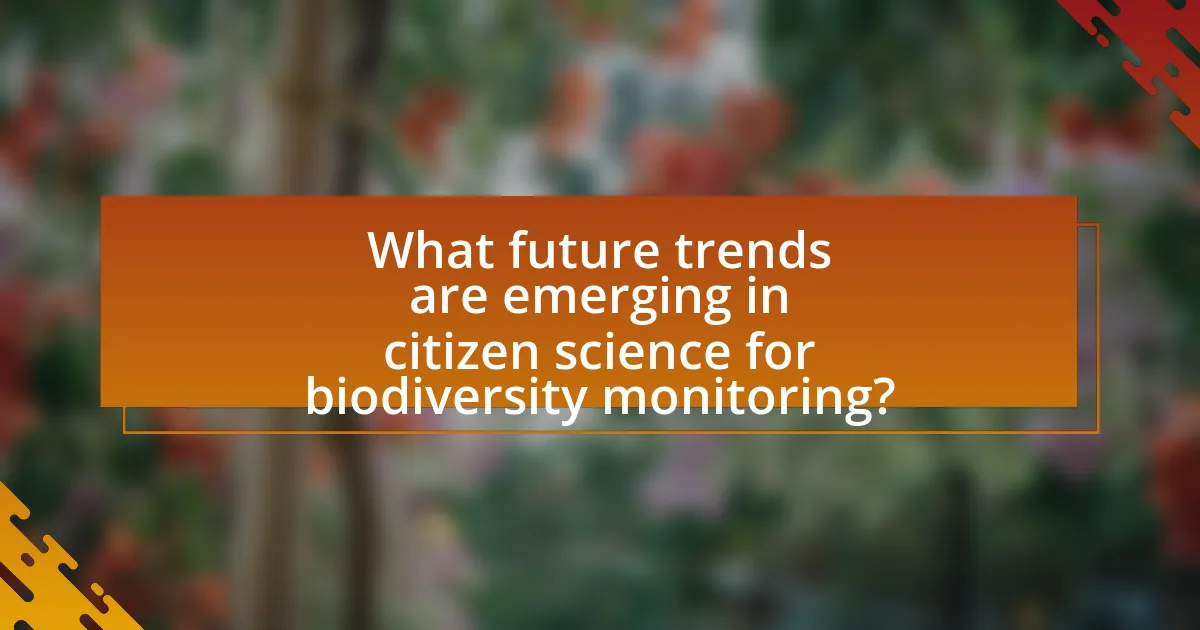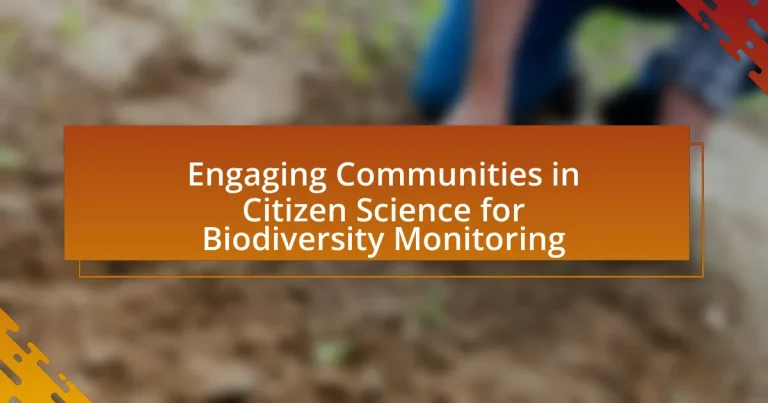Engaging communities in citizen science for biodiversity monitoring involves the active participation of local populations in collecting and analyzing biodiversity data. This approach enhances scientific research by utilizing community knowledge, leading to more localized and comprehensive data collection. The article explores the contributions of citizen science to biodiversity monitoring, the roles of community members, and the methods of data collection and utilization. It also addresses the importance of community engagement, the benefits of involving local populations, and the challenges faced in participation. Additionally, it discusses strategies for fostering involvement, the role of technology, and the implications of citizen science for conservation efforts and policy-making.

What is Engaging Communities in Citizen Science for Biodiversity Monitoring?
Engaging communities in citizen science for biodiversity monitoring involves actively involving local populations in the collection and analysis of biodiversity data. This approach enhances scientific research by leveraging the knowledge and observations of community members, which can lead to more comprehensive and localized data collection. Studies have shown that citizen science initiatives, such as the Global Biodiversity Information Facility, have successfully mobilized thousands of volunteers to contribute to biodiversity databases, thereby improving the understanding of species distribution and ecosystem health.
How does citizen science contribute to biodiversity monitoring?
Citizen science significantly contributes to biodiversity monitoring by enabling non-experts to collect and share data on species and ecosystems. This approach enhances data collection efforts, as seen in projects like the Audubon Society’s Christmas Bird Count, which has gathered over 100 years of data from thousands of volunteers, providing critical insights into bird population trends and habitat changes. Additionally, citizen science fosters community engagement and awareness, leading to increased public interest in conservation efforts and biodiversity preservation.
What roles do community members play in citizen science initiatives?
Community members serve as active participants, data collectors, and educators in citizen science initiatives. They contribute by gathering observations, such as species sightings or environmental data, which are essential for biodiversity monitoring. For instance, in projects like the Audubon Society’s Christmas Bird Count, volunteers record bird populations, providing valuable data for conservation efforts. Additionally, community members often engage in outreach and education, helping to raise awareness about biodiversity issues and fostering a sense of stewardship within their local environments. This involvement not only enhances scientific research but also empowers communities to take an active role in environmental conservation.
How is data collected and utilized in biodiversity monitoring?
Data in biodiversity monitoring is collected through various methods, including field surveys, remote sensing, and citizen science initiatives. Field surveys involve trained researchers systematically observing and recording species in specific habitats, while remote sensing utilizes satellite imagery and aerial photography to assess habitat changes and species distributions. Citizen science engages the public in data collection, allowing volunteers to report species sightings and contribute to databases, enhancing the volume and diversity of data collected. This data is then utilized to track biodiversity trends, inform conservation strategies, and assess the effectiveness of environmental policies, ultimately aiding in the preservation of ecosystems. For instance, the Global Biodiversity Information Facility compiles data from multiple sources, demonstrating the importance of collaborative efforts in monitoring biodiversity.
Why is community engagement important in biodiversity monitoring?
Community engagement is important in biodiversity monitoring because it enhances data collection and fosters local stewardship of natural resources. Engaged communities contribute valuable local knowledge, which can improve the accuracy and relevance of biodiversity data. For instance, studies have shown that citizen scientists can collect data that is comparable in quality to that of trained professionals, as evidenced by the research conducted by Bonney et al. (2014) in “Citizen Science: A Developing Tool for Expanding Science Knowledge and Engagement.” Furthermore, community involvement increases public awareness and support for conservation efforts, leading to more effective biodiversity management strategies.
What are the benefits of involving local communities in scientific research?
Involving local communities in scientific research enhances data collection, increases public awareness, and fosters community ownership of research outcomes. Local communities provide unique insights and knowledge about their environment, which can lead to more relevant and context-specific research findings. For instance, studies have shown that citizen science initiatives, such as those conducted by the Cornell Lab of Ornithology, have significantly improved bird monitoring data accuracy by leveraging local birdwatchers’ expertise. Additionally, engaging communities promotes greater public interest in science, as seen in projects like the Global Biodiversity Information Facility, where local participation has led to increased biodiversity data contributions. This collaborative approach not only enriches scientific research but also empowers communities, making them active participants in conservation efforts.
How does community engagement enhance data quality and reliability?
Community engagement enhances data quality and reliability by fostering local knowledge and increasing participant accountability. When community members actively participate in data collection, they contribute their unique insights and contextual understanding, which can lead to more accurate and relevant data. For instance, studies have shown that citizen scientists often identify species and ecological changes that trained scientists might overlook, thereby enriching the dataset. Furthermore, engaged communities are more likely to adhere to data collection protocols, reducing errors and inconsistencies. Research published in “Citizen Science: Theory and Practice” highlights that projects with strong community involvement report higher data accuracy rates, demonstrating the positive correlation between engagement and data reliability.
What challenges exist in engaging communities for citizen science?
Engaging communities for citizen science faces several challenges, including lack of awareness, varying levels of scientific literacy, and limited access to resources. Many potential participants may not be aware of citizen science initiatives or their benefits, which hinders recruitment efforts. Additionally, individuals with different educational backgrounds may struggle to understand scientific concepts, making it difficult for them to contribute effectively. Furthermore, logistical barriers such as insufficient funding, inadequate training, and lack of technological access can prevent communities from fully participating in these projects. These challenges collectively impede the successful engagement of communities in citizen science efforts aimed at biodiversity monitoring.
What barriers do communities face in participating in citizen science?
Communities face several barriers in participating in citizen science, including lack of access to resources, insufficient training, and limited awareness of opportunities. Access to technology and data collection tools is often restricted, particularly in underserved areas, which hinders participation. Additionally, many community members may not receive adequate training to effectively contribute to scientific projects, leading to feelings of inadequacy or confusion. Furthermore, a lack of awareness about citizen science initiatives can prevent communities from engaging, as they may not know how to get involved or the benefits of participation. These barriers collectively limit the effectiveness and inclusivity of citizen science efforts in biodiversity monitoring.
How can these challenges be addressed effectively?
To address the challenges of engaging communities in citizen science for biodiversity monitoring effectively, it is essential to implement targeted educational programs that enhance awareness and skills among participants. Research indicates that structured training sessions significantly improve participant engagement and data quality, as evidenced by the success of initiatives like the UK’s OPAL (Open Air Laboratories) project, which reported increased community involvement and data collection accuracy after providing comprehensive training. Additionally, fostering partnerships with local organizations can facilitate resource sharing and increase outreach, thereby enhancing community participation.
How can technology facilitate community engagement in citizen science?
Technology facilitates community engagement in citizen science by providing accessible platforms for data collection, communication, and collaboration. Mobile applications and online databases enable individuals to easily contribute observations and findings, thereby increasing participation. For instance, platforms like iNaturalist allow users to upload species observations, which are then verified by experts, fostering a sense of community and shared purpose. Additionally, social media and online forums enhance interaction among participants, promoting knowledge sharing and collective problem-solving. Research shows that projects utilizing technology can significantly boost volunteer involvement, as evidenced by the increase in contributions to biodiversity monitoring initiatives when digital tools are employed.
What strategies can be employed to foster community involvement?
To foster community involvement in citizen science for biodiversity monitoring, strategies such as organizing local workshops, creating accessible online platforms, and establishing partnerships with local organizations can be employed. Local workshops educate community members about biodiversity and the importance of their participation, while accessible online platforms facilitate data collection and sharing, making it easier for individuals to contribute. Partnerships with local organizations enhance outreach and provide resources, ensuring a broader engagement. Research indicates that communities involved in citizen science projects report increased awareness and participation, demonstrating the effectiveness of these strategies in promoting active involvement.

What are the best practices for implementing citizen science projects?
The best practices for implementing citizen science projects include clearly defining project goals, ensuring participant training, and fostering community engagement. Clearly defined goals help participants understand the project’s purpose and expected outcomes, which enhances motivation and data quality. Training participants equips them with the necessary skills and knowledge to collect data accurately, as evidenced by studies showing that well-trained volunteers produce data comparable to that of professionals. Additionally, fostering community engagement through regular communication and feedback creates a sense of ownership and encourages sustained participation, which is crucial for long-term success.
How can project leaders effectively recruit community participants?
Project leaders can effectively recruit community participants by utilizing targeted outreach strategies that resonate with local interests and values. Engaging community members through workshops, informational sessions, and social media campaigns tailored to highlight the benefits of participation, such as skill development and contribution to biodiversity monitoring, increases involvement. Research indicates that projects with clear communication about the impact of citizen science on local ecosystems attract more participants, as seen in studies like “The Role of Citizen Science in Biodiversity Conservation” published in the journal Conservation Biology, which emphasizes the importance of community engagement in successful biodiversity initiatives.
What outreach methods are most effective for engaging diverse communities?
Effective outreach methods for engaging diverse communities include culturally tailored communication, community partnerships, and interactive workshops. Culturally tailored communication ensures that messages resonate with specific cultural values and languages, enhancing relatability and understanding. Community partnerships leverage local organizations to build trust and facilitate access to diverse groups, as evidenced by studies showing increased participation when outreach is conducted through familiar local entities. Interactive workshops provide hands-on experiences that foster engagement and learning, which research indicates significantly boosts involvement in citizen science initiatives.
How can partnerships with local organizations enhance participation?
Partnerships with local organizations can enhance participation by leveraging their established trust and connections within the community. Local organizations often have a deep understanding of community needs and dynamics, which allows them to effectively mobilize residents and encourage involvement in citizen science initiatives. For instance, a study by the National Academies of Sciences, Engineering, and Medicine found that community-based organizations significantly increase public engagement in scientific research by providing resources, outreach, and local knowledge. This collaboration not only fosters a sense of ownership among participants but also ensures that the initiatives are culturally relevant and accessible, ultimately leading to higher participation rates in biodiversity monitoring efforts.
What training and resources are necessary for community members?
Community members require training in data collection methods, species identification, and the use of technology for biodiversity monitoring. This training equips them with the necessary skills to effectively participate in citizen science projects. Resources such as field guides, online training modules, and access to local biodiversity databases further enhance their ability to contribute meaningfully. Studies indicate that well-structured training programs significantly improve the accuracy of data collected by citizen scientists, thereby increasing the overall effectiveness of biodiversity monitoring efforts.
What skills do community members need to contribute effectively?
Community members need skills in data collection, communication, and critical thinking to contribute effectively to biodiversity monitoring in citizen science. Data collection skills enable members to accurately gather and report observations, which is essential for reliable scientific analysis. Communication skills facilitate collaboration and sharing of findings within the community, enhancing collective understanding and engagement. Critical thinking allows members to analyze data and make informed decisions about biodiversity issues, ensuring that their contributions are meaningful and impactful. These skills collectively enhance the effectiveness of community involvement in citizen science initiatives.
How can educational resources be tailored to different audiences?
Educational resources can be tailored to different audiences by customizing content, delivery methods, and engagement strategies based on the specific needs, interests, and backgrounds of each group. For instance, resources aimed at children may use interactive games and visuals, while materials for adults might include detailed reports and case studies. Research indicates that tailoring educational content increases comprehension and retention; a study by the National Academies of Sciences, Engineering, and Medicine found that personalized learning approaches can enhance educational outcomes significantly. By assessing the audience’s prior knowledge and cultural context, educators can create relevant and effective resources that resonate with diverse community members involved in citizen science for biodiversity monitoring.
How can the impact of citizen science projects be measured?
The impact of citizen science projects can be measured through quantitative metrics such as data quality, participant engagement, and biodiversity outcomes. For instance, studies have shown that citizen-generated data can match the accuracy of professional data, as evidenced by a 2016 study published in the journal “Nature” which found that citizen scientists contributed to over 90% of the data used in biodiversity assessments. Additionally, participant engagement can be evaluated through surveys and participation rates, with research indicating that projects with higher engagement levels often lead to more significant conservation outcomes. Furthermore, biodiversity outcomes can be assessed by monitoring changes in species populations or habitats over time, providing concrete evidence of the project’s effectiveness in contributing to biodiversity conservation.
What metrics are useful for evaluating community engagement?
Useful metrics for evaluating community engagement include participation rates, feedback quality, and retention rates. Participation rates measure the number of individuals actively involved in community activities, indicating overall interest and involvement. Feedback quality assesses the depth and constructiveness of community input, reflecting engagement levels and satisfaction. Retention rates track the percentage of participants who continue to engage over time, providing insight into the sustainability of community interest. These metrics collectively offer a comprehensive view of community engagement effectiveness in citizen science initiatives for biodiversity monitoring.
How can success stories be documented and shared?
Success stories can be documented and shared through structured formats such as case studies, reports, and multimedia presentations. These formats allow for the systematic collection of data, narratives, and outcomes related to citizen science initiatives in biodiversity monitoring. For instance, organizations can compile quantitative data on species observed, alongside qualitative testimonials from community participants, to illustrate the impact of their efforts. Sharing these stories can be facilitated via online platforms, social media, and community events, which enhance visibility and engagement. Research indicates that storytelling in science communication significantly increases public interest and understanding, as evidenced by studies showing that narratives can improve retention of information by up to 65%.

What future trends are emerging in citizen science for biodiversity monitoring?
Future trends in citizen science for biodiversity monitoring include the increased use of mobile technology and apps, which facilitate real-time data collection and sharing among participants. This trend is supported by the growing accessibility of smartphones and the development of user-friendly platforms that enable individuals to contribute to biodiversity data collection easily. Additionally, there is a rising emphasis on integrating artificial intelligence and machine learning to analyze large datasets generated by citizen scientists, enhancing the accuracy and efficiency of biodiversity assessments. Collaborative projects that engage diverse communities are also becoming more prevalent, fostering inclusivity and expanding the scope of data collection across various ecosystems. These trends are validated by studies indicating that citizen science initiatives can significantly enhance biodiversity monitoring efforts, as evidenced by the success of platforms like iNaturalist, which has amassed millions of observations from users worldwide.
How is the role of technology evolving in citizen science?
The role of technology in citizen science is evolving through the integration of advanced tools and platforms that enhance data collection, analysis, and community engagement. Technologies such as mobile applications, remote sensing, and artificial intelligence are enabling citizen scientists to gather and process large volumes of biodiversity data more efficiently. For instance, platforms like iNaturalist and eBird allow users to upload observations and contribute to real-time data sets, facilitating collaboration among researchers and volunteers. Additionally, the use of machine learning algorithms helps in identifying species from images, thus streamlining the analysis process. This evolution is supported by the increasing accessibility of technology, which empowers diverse communities to participate in scientific research, ultimately leading to more comprehensive biodiversity monitoring efforts.
What innovations are shaping the future of biodiversity monitoring?
Innovations shaping the future of biodiversity monitoring include the use of artificial intelligence, remote sensing technologies, and mobile applications. Artificial intelligence enhances data analysis by processing large datasets quickly, enabling the identification of species and monitoring of ecosystems with greater accuracy. Remote sensing technologies, such as drones and satellite imagery, allow for real-time observation of habitats and wildlife, facilitating the tracking of changes in biodiversity over time. Mobile applications empower citizen scientists to collect and share data easily, increasing community engagement and expanding the reach of biodiversity monitoring efforts. These innovations collectively improve the efficiency and effectiveness of biodiversity monitoring, as evidenced by studies showing increased data collection rates and enhanced species identification accuracy through these technologies.
How can social media enhance community engagement in citizen science?
Social media enhances community engagement in citizen science by providing platforms for collaboration, information sharing, and outreach. These platforms facilitate real-time communication among participants, allowing them to share observations, data, and experiences, which fosters a sense of community and collective purpose. For instance, studies have shown that projects utilizing social media, such as iNaturalist, have significantly increased participant involvement and data collection rates, demonstrating the effectiveness of these tools in mobilizing community action for biodiversity monitoring.
What are the implications of citizen science for conservation efforts?
Citizen science significantly enhances conservation efforts by mobilizing community involvement in biodiversity monitoring and data collection. This participatory approach increases the volume and diversity of data available for conservation research, as evidenced by studies showing that citizen-collected data can match the quality of professional data in various ecological contexts. For instance, a study published in the journal “Biological Conservation” found that citizen scientists contributed to over 1.5 million observations of species, which informed critical conservation decisions. Furthermore, citizen science fosters public awareness and education about environmental issues, leading to greater community support for conservation initiatives. This engagement not only aids in data collection but also cultivates a sense of stewardship among participants, ultimately enhancing the effectiveness of conservation strategies.
How can citizen science inform policy and decision-making?
Citizen science can inform policy and decision-making by providing robust, community-collected data that enhances the understanding of biodiversity and environmental issues. This data, often gathered through participatory methods, allows policymakers to make evidence-based decisions that reflect the actual conditions and needs of local ecosystems. For instance, studies have shown that citizen science initiatives, such as the Audubon Society’s Christmas Bird Count, have contributed to significant findings on bird population trends, which in turn have influenced conservation policies and habitat protection efforts. By integrating citizen-generated data into policy frameworks, decision-makers can better address ecological challenges and engage communities in the stewardship of their natural resources.
What role does citizen science play in global biodiversity initiatives?
Citizen science plays a crucial role in global biodiversity initiatives by enabling non-professionals to contribute to data collection and monitoring efforts. This participatory approach enhances the scale and scope of biodiversity research, allowing for the gathering of extensive data across various ecosystems and geographical areas. For instance, projects like the Global Biodiversity Information Facility have utilized citizen-contributed data to improve species distribution models, demonstrating the effectiveness of community involvement in scientific research. Additionally, studies indicate that citizen science can increase public awareness and engagement in conservation efforts, fostering a sense of stewardship among participants.
What practical tips can enhance community engagement in citizen science?
To enhance community engagement in citizen science, organizations should prioritize clear communication and accessibility. Clear communication involves providing straightforward instructions and expectations, which can increase participation rates. Accessibility can be achieved by offering diverse participation options, such as mobile apps or local workshops, catering to different skill levels and backgrounds. Research indicates that projects with well-defined roles and responsibilities see higher volunteer retention, as evidenced by a study published in the journal “Citizen Science: Theory and Practice,” which found that structured engagement strategies significantly improved community involvement.


